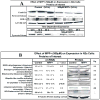Whole genome expression profile in neuroblastoma cells exposed to 1-methyl-4-phenylpyridine
- PMID: 22776087
- PMCID: PMC3470775
- DOI: 10.1016/j.neuro.2012.06.009
Whole genome expression profile in neuroblastoma cells exposed to 1-methyl-4-phenylpyridine
Abstract
Mitochondrial dysfunction and subsequent energy failure is a contributing factor to degeneration of the substantia nigra pars compacta associated with Parkinson's disease (PD). In this study, we investigate molecular events triggered by cell exposure to the mitochondrial toxin 1-methyl-4-phenylpyridine (MPP+) using whole genome-expression microarray, Western Blot and metabolic studies. The data show that MPP+ (500 μM) obstructs mitochondrial respiration/oxidative phosphorylation (OXPHOS) in mouse neuroblastoma Neuro-2a cells, juxtaposing accelerated glucose consumption and production of lactic acid. While additional glucose concentrations restored viability in the presence of MPP+ (500 μM), the loss of OXPHOS was sustained, suggesting that compensatory anaerobic metabolic systems were fulfilling required energy needs. Under these conditions, MPP+ initiated significant changes to the transcription of 439 genes of which 287 DAVID IDs were identified and subsequent functional annotation clusters identified. Prominent changes were as follows; MPP+ initiated loss of mRNA for mitochondrial encoded 3-hydroxybutyratedehydrogenase, type 2(Bdh2), tv1, NADH dehydrogenase 4,5 genes, cytochrome b and NADH dehydrogenase (ubiquinone) flavoprotein 3, concomitant to rise in a mitochondrial fission gene; ganglioside-induced differentiation-associated-protein 1 (GDAP1). The negative changes to OXPHOS components were accompanied by protective forces within the mitochondria espousing elevated ratio of anti/pro-apoptotic processes. These included a loss of apoptotic Bcl-2/adenovirus E1B 19-kDa-interacting protein (BNIP3) and family with sequence similarity 162, member A (FAM162a) and rise of heat shock protein 1 and Lon peptidase 1. There were no changes indicative of free radical damage (e.g. SOD, GSH-Px), rather MPP+ initiated significant elevation in G protein signaling components (which trigger catabolic processes) and anaerobic metabolic systems involving carboxylic acid/transamination reactions (e.g. glutamate oxaloacetate transaminase 1 (GOT1), glutamic pyruvate-alanine transaminase 2 (GPT2), cystathionase and redox proteins such as cytochrome b5 reductase 1 and ferredoxin reductase. Counter-intuitively, the data show reduction of mRNA in glycolytic processes [DAVID enrichment score 9.96 p value 1.90E-19], some corroborated by Western Blot, bringing in to question the sources of lactate observed in the presence of MPP+. Examining this aspect, the data show that diverse carboxylic acids (succinate, oxaloacetate and a-ketoglutarate) are capable of contributing to the lactate pool in addition to phosph(enolpyruvate) or pyruvate in the absence of glucose by this cell line. In conclusion, these findings show that MPP+ negatively affects the transcriptome involved with complex I, but initiated an elevation of G protein signaling and anaerobic metabolic systems involved with nitrogen/carboxylic acid metabolism. Future research will be required to elucidate the survival pathways that drive anaerobic substrate level phosphorylation, and define functional ramification to the loss of mitochondrial FAM162a and BNIP3 proteins.
Copyright © 2012 Elsevier Inc. All rights reserved.
Figures











Similar articles
-
D-(+)-glucose rescue against 1-methyl-4-phenylpyridinium toxicity through anaerobic glycolysis in neuroblastoma cells.Brain Res. 2003 Feb 7;962(1-2):48-60. doi: 10.1016/s0006-8993(02)03695-8. Brain Res. 2003. PMID: 12543455
-
Variable toxicological response to the loss of OXPHOS through 1-methyl-4-phenylpyridinium-induced mitochondrial damage and anoxia in diverse neural immortal cell lines.Cell Biol Toxicol. 2010 Dec;26(6):527-39. doi: 10.1007/s10565-010-9161-7. Epub 2010 Apr 18. Cell Biol Toxicol. 2010. PMID: 20401737 Free PMC article.
-
Effects of enhancing mitochondrial oxidative phosphorylation with reducing equivalents and ubiquinone on 1-methyl-4-phenylpyridinium toxicity and complex I-IV damage in neuroblastoma cells.Biochem Pharmacol. 2004 Mar 15;67(6):1167-84. doi: 10.1016/j.bcp.2003.11.016. Biochem Pharmacol. 2004. PMID: 15006552
-
Acetyl-L-carnitine cytoprotection against 1-methyl-4-phenylpyridinium toxicity in neuroblastoma cells.Biochem Pharmacol. 2003 Jul 15;66(2):297-306. doi: 10.1016/s0006-2952(03)00261-2. Biochem Pharmacol. 2003. PMID: 12826272
-
Cx43 Mediates Resistance against MPP⁺-Induced Apoptosis in SH-SY5Y Neuroblastoma Cells via Modulating the Mitochondrial Apoptosis Pathway.Int J Mol Sci. 2016 Nov 1;17(11):1819. doi: 10.3390/ijms17111819. Int J Mol Sci. 2016. PMID: 27809287 Free PMC article.
Cited by
-
Construction and Validation of a Novel Glycometabolism-Related Gene Signature Predicting Survival in Patients With Ovarian Cancer.Front Genet. 2020 Nov 12;11:585259. doi: 10.3389/fgene.2020.585259. eCollection 2020. Front Genet. 2020. PMID: 33281878 Free PMC article.
-
The Role of Monocarboxylate Transporters and Their Chaperone CD147 in Lactate Efflux Inhibition and the Anticancer Effects of Terminalia chebula in Neuroblastoma Cell Line N2-A.European J Med Plants. 2016;12(4):EJMP.23992. doi: 10.9734/EJMP/2016/23992. Epub 2016 Feb 22. European J Med Plants. 2016. PMID: 27158628 Free PMC article.
-
Transcriptional and metabolic adaptation of human neurons to the mitochondrial toxicant MPP(+).Cell Death Dis. 2014 May 8;5(5):e1222. doi: 10.1038/cddis.2014.166. Cell Death Dis. 2014. PMID: 24810058 Free PMC article.
-
The developmental effects of pentachlorophenol on zebrafish embryos during segmentation: A systematic view.Sci Rep. 2016 May 16;6:25929. doi: 10.1038/srep25929. Sci Rep. 2016. PMID: 27181905 Free PMC article.
-
Nr1h4 and Thrb ameliorate ER stress and provide protection in the MPTP mouse model of Parkinson's.Life Sci Alliance. 2024 Apr 12;7(7):e202302416. doi: 10.26508/lsa.202302416. Print 2024 Jul. Life Sci Alliance. 2024. PMID: 38609183 Free PMC article.
References
-
- Absi E, Ayala A, Machado A, Parrado J. Protective effect of melatonin against the 1-methyl-4-phenylpyridinium-induced inhibition of complex I of the mitochondrial respiratory chain. J Pineal Res. 2000;29:40–7. - PubMed
-
- Akashi S, Kimura T, Takeuchi T, Kuramochi K, Kobayashi S, Sugawara F, et al. Neoechinulin a impedes the progression of rotenone-induced cytotoxicity in PC12 cells. Biol Pharm Bull. 2011;34:243–8. - PubMed
-
- Araki T, Milbrandt J. Ninjurin, a novel adhesion molecule, is induced by nerve injury and promotes axonal growth. Neuron. 1996;17:353–61. - PubMed
Publication types
MeSH terms
Substances
Grants and funding
LinkOut - more resources
Full Text Sources
Research Materials
Miscellaneous

